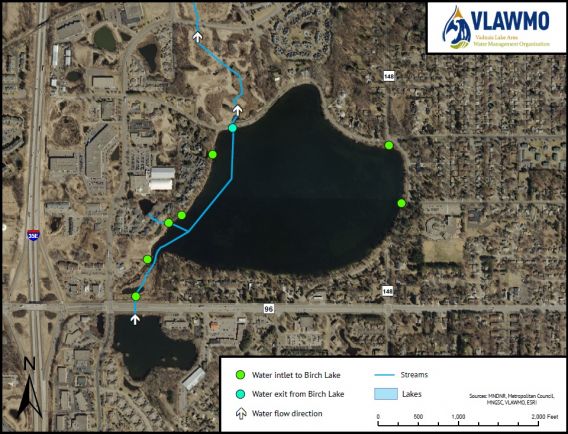Birch Lake Shoreline Update
Recently in VLAWMO, Birch Lake underwent its annual shoreline restoration maintenance. So why does a shoreline require annual maintenance, and what does “restored” mean if the shoreline was always there to begin with?
Starting in 2010, VLAWMO collaborated with the City of White Bear Lake and Birch Lake Improvement District (BLID) an organization of nearby homeowners to restore the shoreline. Additional funding came from the MN DNR and the Ramsey Conservation District. While the shoreline has been lush with grass and foliage for many years, a shoreline restoration takes into account what types of foliage are present, and how water flows into the lake. As with many suburban lakes, the shoreline goes through lots of changes as roads are built, foot traffic increases, and boat access becomes more popular. These changes aren’t bad in themselves, but over time can influence the water quality of the lake. With a bit of management of the shoreline, common influences such as erosion, winter road salt, and leftover grass clippings would have less of an effect on the water, allowing visitors to enjoy it more.
Shoreline efforts such as this work to establish the original plant communities and their function of keeping water clean and protected. Looking at the map below, we see that there are several stormwater inlets directing water into the lake. A healthy shoreline with robust native plant communities is able to grab contaminants as they move through these inlets and wash off the street. Additionally, the native plant’s deep root systems support the shoreline from eroding and bringing sediment into the lake during rain events. Such sediment can smother plant, insect, and therefore fish communities.

Citizen volunteers along with Natural Shoreline Technologies have planted and maintained the shoreline since its early beginnings in 2010. Seasonal maintenance keeps the project reaching its full potential by clearing out the undesired plants and giving space for the desired native plants to flourish. Maintenance also tends the rock walking paths along the shore, allowing visitors while keeping the soil intact. As this happens, bees, butterflies, dragonflies, and birds are seen on the shore as they notice their favorite food sources and nesting spaces.
Because Birch Lake’s water quality is favorable, the shoreline project is a great example of preventing a problem before it starts. From the table below, we see that Birch Lake’s phosphorous levels (commonly from grass clippings) as well as Secchi disk measurement (how deep the water visibility is) are in good shape. We can also see that chloride (salt) levels have the most potential to be an issue in the future. According to the Minnesota Pollution Control Agency, one teaspoon of road salt can permanently pollute 5 gallons of water. With its close proximity to 35E and Highway 96, Birch Lake holds potential for salt pollution if several rough winters strike. The remedies for this issue are then 1) practicing proper salt application and 2) maintaining a native shoreline for a protective layer around the lake. With its healthy and hardy shoreline, Birch Lake has years of recreation and clean water ahead!
|
|
Secchi Disk Depth (deeper=good) |
Total Phosphorus (TP) (lower=good) |
Chloride (CL) (lower=good) |
|
Birch Lake Water Quality (5/17/2016) |
2 meters |
.019 mg/L |
80.3 mg/L |
|
Minnesota Standard |
≥ 1 meter |
< .06 mg/L |
230 mg/L |

